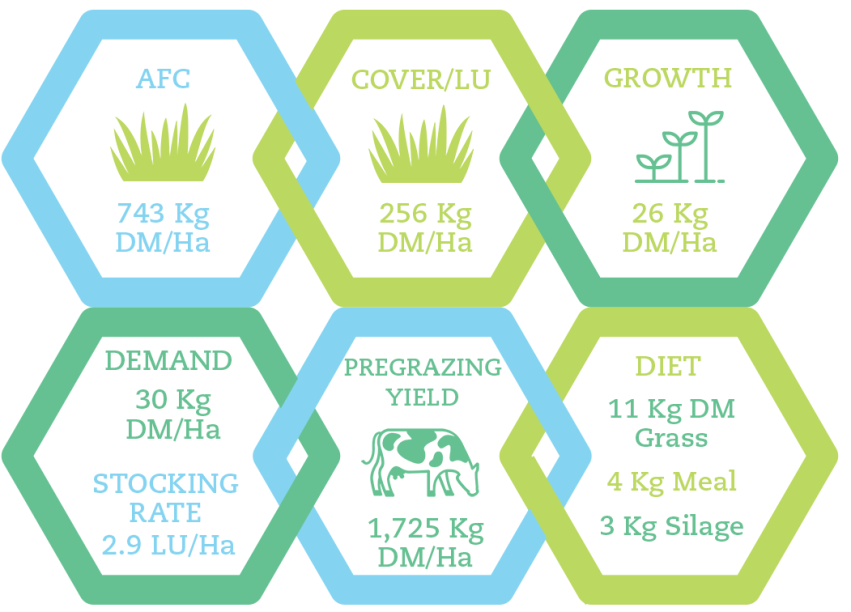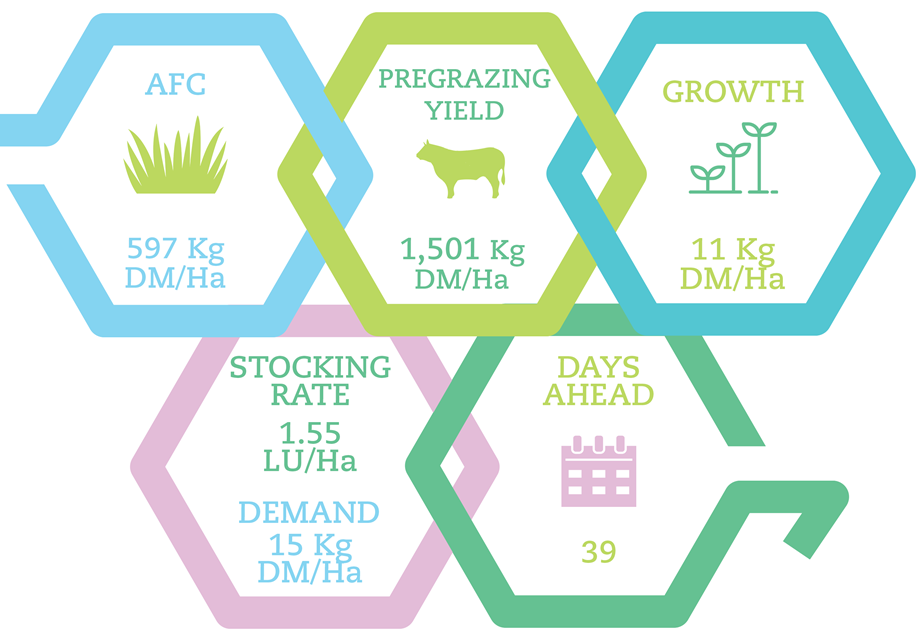02 November 2022
Grass 10 Weekly Update November 1st

Advice and information from the Grass 10 team this week includes Wet weather management to keep animals on grass. December 1st closing cover is a priority. Now is the time to identify grazing infrastructure improvements. This weeks Clover Reporter is Ger Pardy from Co. Offaly
PastureBase Ireland – Dairy Figures

- Average Farm Cover – 741 Kg DM/Ha
- Cover/LU – 256 Kg DM/Ha
- Growth – 26 Kg DM/Ha
- Demand 30 Kg DM/Ha – Stocking rate 2.9 LU/Ha
- Pregrazing yield – 1,725 Kg DM/Ha
- Diet – 11 Kg DM Grass – 4 Kg Meal – 3 Kg Silage
Predicted Grass Growth
 Counties map showing predicted grass growth in kg DM/ha/day over the next 7 days. This is from farms involved in Elodie Ruelle’s MoSt grass growth model on 78 farms.
Counties map showing predicted grass growth in kg DM/ha/day over the next 7 days. This is from farms involved in Elodie Ruelle’s MoSt grass growth model on 78 farms.
Growth rates vary across the country ranging with lows of 10 in Clare, 11 in Donegal and Wicklow and 12 in the other western counties. Highs this week are 17 and 18 in Cork, Limerick, Tipperary. Meath, Kildare are of 23 to 25 in counties in the midlands and north east.
Predicted rainfall
 Counties map showing predicted rainfall in mm for the next 7 days from farms involved in Elodie Ruelle’s MoSt grass growth model – 78 farms.
Counties map showing predicted rainfall in mm for the next 7 days from farms involved in Elodie Ruelle’s MoSt grass growth model – 78 farms.
Rainfall is predicted to have highs of 42 to 49 in Cork, Waterford, Kerry, Clare and Mayo. Predicted lowest rainfall this week is in the eastern counties of Louth, Meath, Kildare, Cavan and Laois where it ranges from 26 to 30 lows of 39 to 50 in the west and north west.
Grass Dry Matter %

- Moorepark 10%
- Ballyhaise 10%
Grass 10 Weekly Tips

- Most farmers should have 60-70% of their farm closed today
- December 1st closing cover is the number one priority now
- Wet weather management to keep animals at grass
- Identify grazing infrastructure improvements
Most farmers should have 60-70% of their farm closed today
Most farms should have between 60-70% of their farm closed by 1st November. This is to lengthen the grazing season in the autumn and the spring. Most of the grass available in the spring grows during October! Farms on heavy soils have struggled to keep grazing this week and grazing infrastructure is vital. Many higher stocked farms will have close to 80% closed as their demand for grass in the spring is much higher and grass in the spring is more profitable. If behind graze lighter covers now to catch up. The remainder of the farm left to graze should be the ones to graze last in the spring.
December 1st closing cover is the number one priority now
With most of the farm closed, the priority has to be looking ahead to match your opening average farm cover in the spring to your demand for grass in the spring. Every day at grass next spring will be worth about €4 per cow per day on a dairy farm, or about €2.75 per LU on a beef farm. Herds with a big demand on dry soils can require 1100-1200 Kg DM/ha in early February whilst lower stocked farms requiring 900-1000 Kg DM/ha and heavy soils around 800 Kg DM/ha, which is weather dependent. Using these figures as guides for your farm. You can subtract your winter growth which can range from nearly zero on colder, wetter soils to 5-6 Kg DM/ha per day on drier, warmer soils.
Typically over winter growth stands around 3 Kg DM/ha per day, or around 200 Kg DM/ha of growth over the winter. This allows us to work out what our closing farm cover on December 1st should be, the diagram below also gives guidance.
2.5 LU/ha – 650-700 KgDM/ha
3.0 LU/ha – 700-750 KgDM/ha
3.5 LU/ha – 750-800 KgDM/ha
If animals are out grazing, you need to continue to walk the farm. Neglecting to do this results in being below the target closing cover and in a grass deficit in the spring. This will make spring 2023 a lot more expensive so it pays to walk grass – even in November!
REMINDER:
PBI will be unavailable from 7pm Sunday 6th to 6pm Wednesday 9th of November to allow for a systems hardware update.
Wet weather management to keep animals at grass
Extremely heavy rainfall over the past week has made grazing conditions challenging across the country. More rain is forecast for the week coming. Conditions like these call for top grazing infrastructure and management to keep stock out grazing. Being able to move stock frequently and not let them run back onto previously grazed areas is crucial. This requires stripwires in front of and in some cases a back fence behind to minimise hoof damage and poaching.
Farmers have regularly given feedback that the 2nd grazing on the same area is the one that does the damage, so move frequently. Access points are key to allow stock movement in and out through different entry points. Heavy soils farms are well set up for this type of grazing and they also use spur-roadways to get cattle to graze from the back of the paddocks and work their way up. View Paudie O’ Brien’s spur-roadway video at this link
The priority is to first feed the stock, then avoid poaching, and then graze out tight. If farms have to house stock, try on-off grazing to get any remaining area grazed. Silage management is critical during on-off grazing. It’s improtant animals don’t go out grazing when full on silage. So restriction of silage before animals go grazing is important. Be flexible – if housed, getting out again in November may be an option to graze off heavy covers before the winter.
Identify grazing infrastructure improvements
With the onslaught of heavy rain during October, there has never been a better time to assess grazing infrastructure on your farm due to the challenge of keeping animals out at grass. Could you be grazing this week if you had extra roadways, access points, spur-roads, fencing, water troughs, etc. available on your farm? Identify infrastructure you need to improve in 2023. Write it down on your 2023 to-do list, and save a reminder on your phone for next summer to make the improvements when the weather conditions are good!
Figure 1: Ideal Closing Farm Cover 1st December 650-700 Kg DM/Ha 
This graph shows the relationship between the 60:40 autumn rotation planner and the average farm cover (AFC) target in order to close up the farm in the autumn with the appropriate quantity of grass for the spring. The objective here is to have an AFC of 650-700 KgDM/ha on December 1st this would be sufficient for a farm stocked at 2.5 LU/ha in the spring. If the demand for grass is higher, then the target AFC on December 1st should increase to 750-800 KgDM/ha depending on farm circumstance. Remember spring grass is a lot more profitable than autumn grass, avoid the temptation and get 2023 off to a flying start!
PastureBase Ireland – Drystock Figures

- Average Farm Cover – 645 Kg DM/Ha
- Pregrazing yield – 1,603 Kg DM/Ha
- Growth – 17 Kg DM/Ha
- Stocking rate – 1.95 LU/Ha
- Demand – 27Kg DM/Ha
- Days ahead – 24
The Clover Reporter
Ger Pardy, Co Offaly
This week, we return to dairy farmer Ger Pardy. Ger is farming with his family outside Birr, Co. Offaly. The farm will grow an estimated 13.5 T DM/ha this year from a total 98 Kg N/ha including slurry. Ger is on track to deliver over 500 KgMS/cow on just under 700 Kg meal/cow.
Location: Birr, Co. Offaly
Enterprise: Dairy
Soil Type: Dry & Clay soils
% Farm In Clover: 100% (78ha) – (>60% enough to reduce N)
% From Reseeding: 10% (8ha)
% From Oversowing: 90% (70ha)
Clover content 2021: 23% on best. 12% on remainder
Grazing Management to prevent bloat
Bloat can be an issue in swards with high white clover content. Bloat can occur at any time of the year but it is more likely to occur in the second half of the year when white clover content in the sward is highest. Good grassland management can minimise and prevent the risk of bloat
- Avoid switching between grass-only and grass-white clover swards, as much as is possible
- Avoid having cows hungry entering a fresh paddock. Keep post-grazing sward height at or just above 4 cm, not below. This will ensure that cows are fed to appetite and will be consuming a mixture of grass and clover. They will not be hungry when they move to a fresh paddock/break and therefore will not have a large intake of clover in a short period of time.
- When entering a grass-white clover paddock in risky conditions – high white clover content / hungry animals / wet morning / very lush pasture) provide a small area in the paddock for the first 2-3 hours after turn-out to prevent the initial gorging on white clover.
- Provide anti-bloating agent in the water supply – starting the day prior to entering the risky paddock.
- Offer a fibre source such as silage, hay or straw at milking time for example i.e. 0.5 – 1 kg DM per cow.
- Check cows after initial turnout and regularly for first three hours of grazing during high risk periods


